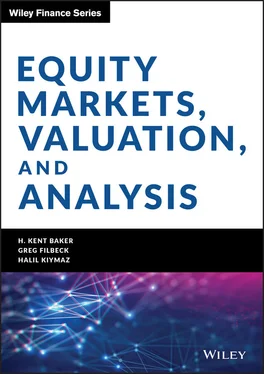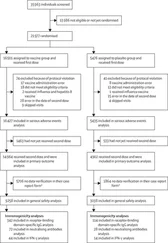1 Visual Capitalist. 2016. “All the World's Stock Exchanges by Size.” Available at http://www.visualcapitalist.com/all-of-the-worlds-stock-exchanges-by-size/.
2 World Bank. 2018. “Market Capitalization of Listed Domestic Companies.” Available at https://data.worldbank.org/indicator/CM.MKT.LCAP.CD?end=2017&start=1975.
3 World Federation of Exchanges. 2019. “Welcome to the Future of Markets.” Available at https://www.world-exchanges.org/.
PART One Background
CHAPTER 2 Ownership Structure and Stock Classes
Christopher J. Barnesler
Equity Research, Deutsche Bank AG
Ehsan Nikbakhtler
C. V. Starr Distinguished Professor of Finance and International Financial Services
Frank G. Zarb School of Business, Hofstra University
Andrew C. Spieler
Robert F. Dall Distinguished Professor of Business
Frank G. Zarb School of Business, Hofstra University
A commonly held view is that all common stock issues are the same. Although overwhelmingly true for most companies, several exceptions exist to this concept. The most apparent exception is multiple-class common stock, more commonly known as dual-class stock , which offers shareholders in one class of stock superior voting rights relative to shareholders in a separate class.
Before comparing single-class and dual-class common stock, single-class common stock can be divided into various structures. For example, besides the primary listing of a single class of common stock, a company may cross-list its shares on stock exchanges in other countries. Depositary banks may create an analogous share for investors to partake in ownership of a foreign listed company. Cross-listings and depositary receipts each facilitate investment in corporations whose primary listings are in other countries. Although cross-listings represent a direct listing on the foreign stock exchange, depositary receipts are indirect ownership vehicles, where an intermediary institution holds shares directly and offers receipts certifying ownership.
Tracking stock represents yet another type of single-class common stock. Unlike most cases of common stock where shares represent ownership claims on a corporation's assets, investors in tracking stock have no such claim, as their investment targets the financial performance of a subdivision of a larger corporation. Occasionally, companies may choose to merge business operations without effectuating a legal merger. This pseudomerger allows retaining two legal identities. These dual-listed companies try to equalize ownership such that a share of one twin equals a share in the other. Yet, each twin's shares correspond to different underlying legal entities and create some differences between shares.
This chapter presents an overview of these special instances of common stock. The remainder of the chapter is organized as follows. The next section describes several instances of single-class common equity by separating cross-listings, depositary receipts, tracking stock, and dual-listed companies. The subsequent section describes multiple-class common stock (dual-class stock). Finally, the chapter offers a summary and conclusions regarding single-class and dual-class common stock.
SINGLE-CLASS COMMON EQUITY
Equity represents the net value of a company's assets over its liabilities, which would be attributable to all company owners in the event of a liquidation. This net asset value can be further divided between the two primary forms of equity: common and preferred. Preferred equity has a more senior claim, relative to common equity, on the company's assets and receives priority when the company declares and pays dividends. However, this seniority typically results in limited or no voting rights for preferred shareholders. Conversely, common equity gives holders the right to vote on specific corporate issues, including the election of the board of directors, corporate objectives and policy, and acquisitions and divestitures. Shares of common equity represent fractional ownership interests of the company, entitling owners to the profits generated by the company remaining after making all contractual payments to senior capital providers. In the event of liquidation or dissolution, common equity holders only receive the remainder of funds, if any, after satisfying all other stakeholders with primacy on the company's assets. Although common stockholders elect the board of directors, the enfranchisement of common stock typically has little value, except in proxy contests for control because the board of directors makes most major corporate decisions or delegates them to company employees (Bainbridge 1991).
Although all forms of common stock share in a corporation's profits, common stock can be broadly categorized into two forms: single-class and dual-class. In a single-class equity structure, each share has an equivalent number of votes, conferring a manner of shareholder democracy as each share receives an equal degree of influence. To control a single-class company, one must amass a majority of shares, therefore tying economic performance with control. Voting rights and control represent the primary difference between single- and dual-class stocks. In the latter, shareholders can control companies while holding a disproportionate (typically small) economic interest in the company.
This section describes several different types of share structures. A cross-listing enables corporations to offer their shares on multiple exchanges, perhaps in different countries, while representing the same fundamental underlying ownership in the company. Depositary receipts and cross-listings share many characteristics, but the former represents an indirect ownership claim. Dual listings are a less frequent structure in which two companies merge operations but retain separately listed stocks in different countries. Finally, tracking stock is a special case of parent corporation stock whose value is linked to the financial performance of a subsidiary rather than the parent.
Increasing integration of global financial markets and globalization have contributed to more companies choosing to list their shares on other exchanges outside their domestic market. A cross-listed company offers its stock for trading directly on multiple exchanges, one on a domestic exchange and at least one other exchange located in a foreign market. Baker, Nofsinger, and Weaver (2002) find that international cross-listings on the New York Stock Exchange (NYSE) or London Stock Exchange (LSE) raise investor recognition significantly, while also reducing the cross-listed firm's overall cost of capital.
Cross-listed shares reduce existing market frictions, such as currency or custody requirements, associated with foreign ownership of common stock. For example, consider a U.S. incorporated multinational company that wants to broaden its investor base in Japan. This company could issue shares on the Tokyo Stock Exchange, which would trade in Japanese yen in the home market of Japanese investors, perhaps raising visibility with investors in a new market.
Like depositary receipts, which are described in the next subsection, cross-listed shares are fungible for the same company's shares on another exchange. Unlike a depositary receipt, which represents shares held by a custodian, cross-listings are direct ownership vehicles in the subject company. The local exchange may demand reporting and corporate governance obligations to qualify for trading and comply with local laws and regulations. According to Dobbs and Goedhart (2008), the idea that cross-listings create value is dated because capital markets have become more globalized and integrated. Additionally, trading liquidity in the cross-listed markets often pales in comparison to the primary market's. Therefore, the potential benefits do not justify the costs for compliance with additional exchange rules, notably for companies cross-listing into the United States. In contrast, Roosenboom and van Dijk (2009) conclude that a firm's cross-listing shares on developed market exchanges, such as the NYSE or LSE, do create shareholder value by way of bonding to heightened investor protection laws and increased information disclosure of the developed market. Bonding is the process by which companies located in countries with lax regulation align themselves with more stringent financial disclosure and corporate governance standards by cross-listing onto a developed market exchange.
Читать дальше












